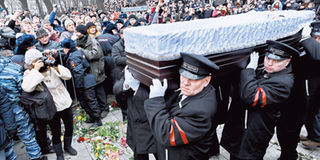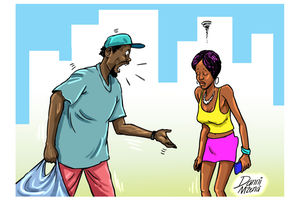Battle to honour slain Putin critic Nemtsov unfolds beneath Kremlin

Funeral assistants carry the coffin of Russian opposition leader Boris Nemtsov after a memorial service at the Andrei Sakharov rights centre in Moscow on March 3, 2015. PHOTO | FILE
What you need to know:
“This is about remembering,” Boris Kazadayev, 73, part of the small crowd, told said. “If there is no collective memory, the country won’t have a future.”
As the Kremlin clock inched towards midnight and the ice-bound river beneath their feet melted, a group of Russians silently stood on the bridge where Boris Nemtsov, the Putin critic and opposition leader, was killed nearly a year ago.
“This is about remembering,” Boris Kazadayev, 73, part of the small crowd, told said. “If there is no collective memory, the country won’t have a future.”
Moments later, a snow plough mounted the pavement forcing the crowd to the kerb. Two trucks then reversed within inches of people’s backs and trapped them before dumping piles of snow around them.
“Nemtsov Bridge” - activists’ nickname for the spot where the Putin opponent was shot dead on Feb. 27 last year - has become the scene of a cat-and-mouse struggle between the authorities and the liberal opposition who want to honour a man some Russians say the Kremlin would rather forget.
Supporters bring flowers for a makeshift shrine; the authorities sweep the site clean; his supporters rebuild. It’s a sequence that has played out repeatedly, in all weathers, for at least 300 days.
“It is a model of peaceful resistance that is unique for modern Russia,” said Olga Shorina, a Nemtsov ally.
“It has become a symbol of the fact that there’s a desire for an alternative.”
Activists say they will continue until a plaque is erected on the bridge to honour Nemtsov, a former deputy premier turned tenacious opposition leader. The authorities have refused.
Some activists also want the bridge to be renamed after him. That too has been rejected.
In a country where the Soviets air brushed people out of history but immortalised their heroes by burying them at the foot of the Kremlin wall or, in Vladimir Lenin’s case placed him in a mausoleum on Red Square, the battle is seen by some as one for Russians’ memories that could help determine their future.
“The authorities are doing everything they can to ensure Russians forget about my father,” Zhanna Nemtsova, 31, said. “Their aim is not only to control the state but also to control people’s minds and hearts.” The nearly year-long standoff has had an unexpected consequence: The spot where Nemtsov was murdered has become a unique if modest rallying point for the liberal opposition in what they say is an otherwise bleak political landscape.
Passers-by stop to look, opposition-minded Russians gather there to exchange ideas, and the Russian flag can sometimes be seen defiantly flying, visible from Red Square.
“It’s an island of freedom in a zombified country,” said Sasha Chernyavsky, a 29-year-old DJ.
The location, so close to the Kremlin’s terracotta walls and the phantasmagorical onion domes of St Basil’s Cathedral, packs rare symbolic punch.
“We will not allow, in the centre of Russia, in the very heart of Moscow, next to the Kremlin, for a bridge to be named after a person who always supported the interests of America and spat on the interests of Russia,” SERB, a nationalist group that vandalised the site at least twice, has complained.
In flux due to its regular destruction, the makeshift memorial has a few constants: flowers, icons, candles, written tributes and portraits.
“I don’t like being shot in the back,” reads one note, a reference to the fact that Nemtsov was shot from behind.
Each day at 23.31, the time Nemtsov was killed, his supporters observe a minute of silence.
Nemtsov, 55, was killed as he walked home with his girlfriend after dinner. Putin, after his murder, described him as one of his fiercest critics.
Nemtsov helped found the country’s main anti-Kremlin movements and spoke at opposition rallies. He had authored an excoriating report into Putin’s tenure, and shortly before he was killed was working on a report examining the Russian military’s role in Ukraine.
Revered by his supporters as an unpretentious man of the people, some Russians disliked him, associating him with the 1990s, a period of food shortages when he was a deputy prime minister.
“What did he do for Russia?” Valentina Arsentieva, a reader of pro-Kremlin lifenews.ru, wrote the day after his killing.
“We were eating animal feed in the 1990s while THEY were selling Russia out to the West.”
State TV largely ignored him in recent years. But his profile in the 1990s meant he remained a household name.
Within hours of his murder, hundreds of Russians flocked to the scene to leave flowers.
The writer filed this article from Moscow




